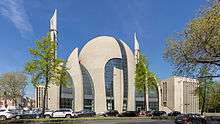Turkish-Islamic Union for Religious Affairs




The Turkish-Islamic Union for Religious Affairs (German: Türkisch-Islamische Union der Anstalt für Religion e.V., Turkish: Diyanet İşleri Türk-İslam Birliği), usually referred to as DİTİB, is one of the largest Islamic organisations in Germany. Founded in 1984 as a branch of the Presidency of Religious Affairs in Ankara, it is an "arm" of the Turkish state.[1] The headquarters are in Cologne-Ehrenfeld.
As of 2016, the DITIB funds 900 mosques in Germany.[1]
The imams and the religious teachers are sent from Turkey. Because the state back then was almost bankrupt, the officials had to be paid with money from the Muslim World League, which provoked protest from secularists. The fixation on Turkey and the Turkish language proved to be a handicap, because other Islamic organisations used German language in public. The usage of German was seen by many to be more dialogue-friendly.
Organisation
When it was initially founded, around 230 associations were members; by 2005 the number was 870. The local associations are registered independently for legal and financial purposes, but share the goals and principles of DİTİB as their foundation. They also acknowledge DİTİB as their umbrella-organisation. It has a number of social and religious institutes.
2004 rally
Under the presidency of Rıdvan Çakır, DİTİB tries to present itself as a more integrated actor in German society. DİTİB was one of the initiators of the mass-event "Gemeinsam für Frieden und gegen Terror" (en: "Together for Peace and against Terror"). Over 20,000 Muslims participated in this demonstration, which was held on November 21, 2004 in Cologne. Participants who gave speeches included the Green Party politician Claudia Roth, Bavaria's Interior Minister Günther Beckstein and Fritz Behrens. The goal was to signal the disapproval of the use of violence in the name of Islam. It was one of the largest demonstrations of its kind in the history of Germany.
See also
References
- 1 2 "Old Faultlines". The Economist. 6 August 2016. Retrieved 9 August 2016.
External links
- DİTİB Homepage